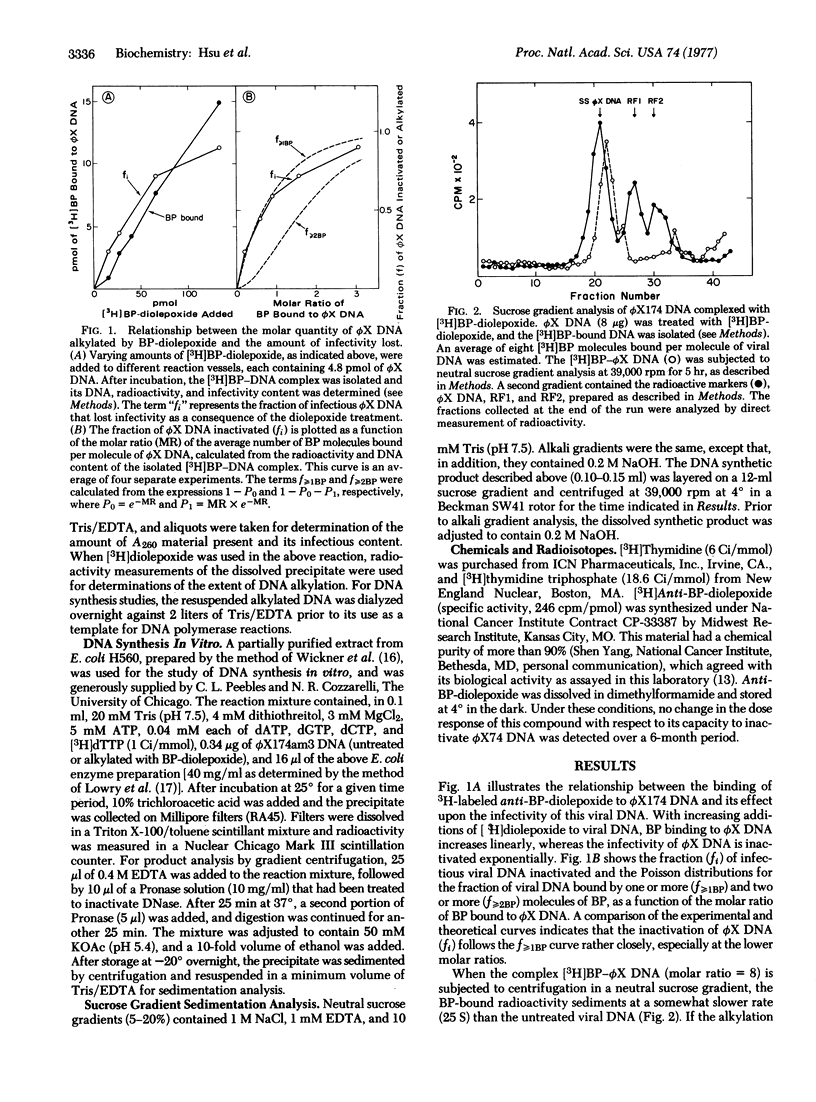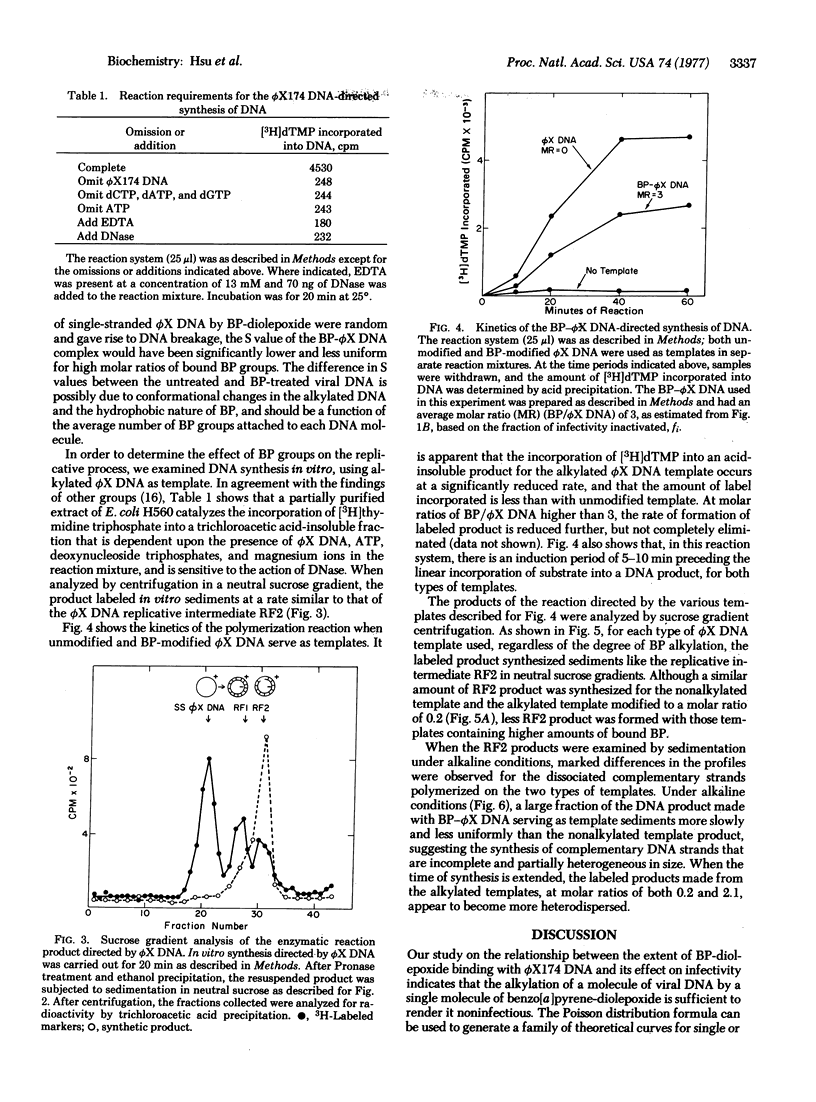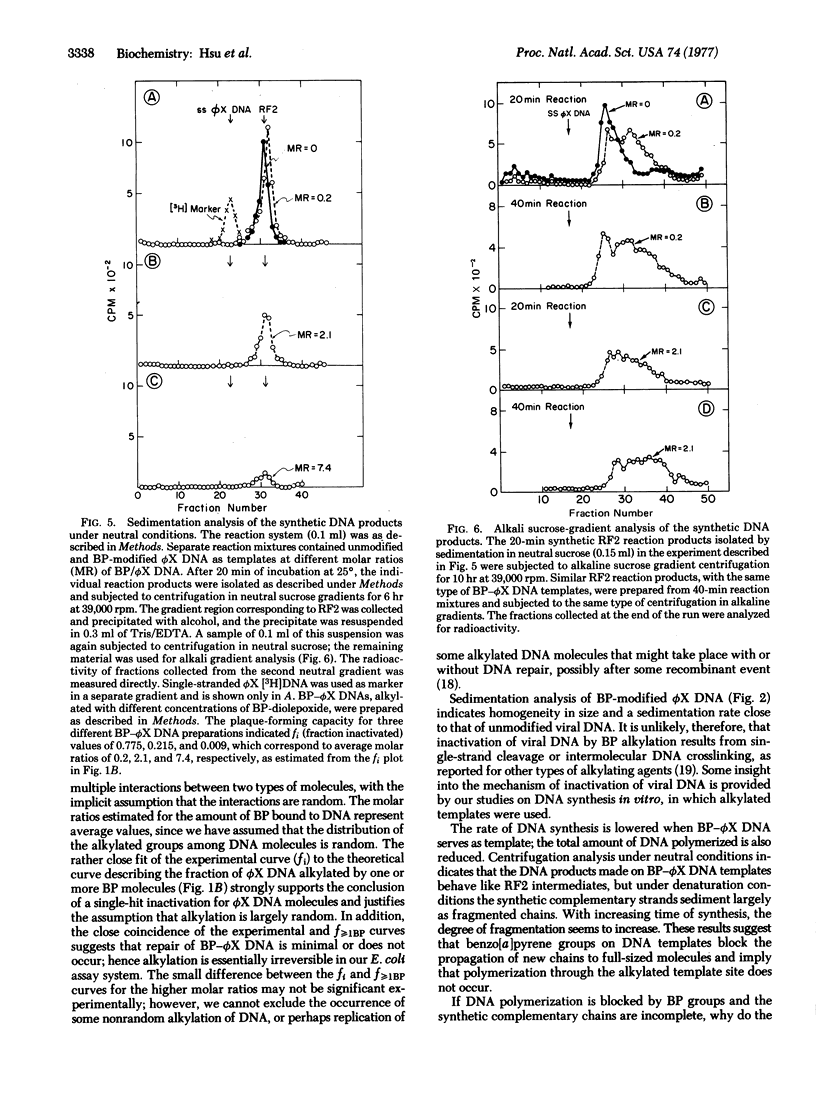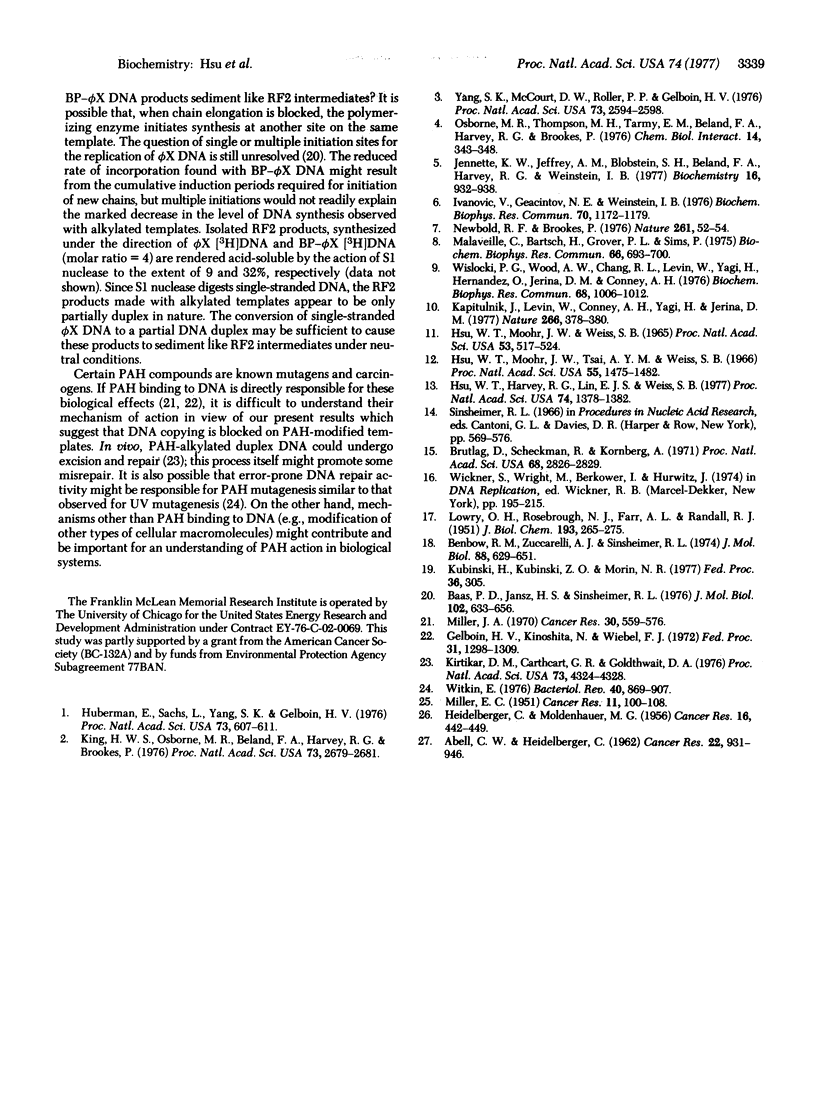Abstract
A previous report from this laboratory has shown that certain derivatives of polycyclic aromatic hydrocarbons bind to phiX174 DNA and render it noninfectious. The present work describes the relationship between the extent of phiX174 DNA binding by (+/-)-anti-benzo[a]pyrene-7,8-dihydrodiol-9,10-epoxide and the effect on infectivity. The results suggest that one molecule of bound diolepoxide is sufficient to inhibit the replication of a single molecule of phiX174 DNA. DNA synthesis studies, in vitro, indicate that when phiX DNA bound by benzo[a]pyrene groups serves as template the rate of DNA polymerization is reduced and less product is formed. In addition, the propagation of synthetic DNA strands is blocked so that incomplete complementary chains are assembled. The relationship of these findings to the mutagenic and carcinogenic process associated with the action of benzo[a]pyrene-diolepoxide is discussed.
Full text
PDF




Selected References
These references are in PubMed. This may not be the complete list of references from this article.
- ABELL C. W., HEIDELBERGER C. Interaction of carcinogenic hydrocarbons with tissues. VIII. Binding of tritiumlabeled hydrocarbons to the soluble proteins of mouse skin. Cancer Res. 1962 Sep;22:931–946. [PubMed] [Google Scholar]
- Baas P. D., Jansz H. S. Bacteriophage phiX174 DNA synthesis in a replication-deficient host: determination of the origin of phiX DNA replication. J Mol Biol. 1976 Apr 15;102(3):633–656. doi: 10.1016/0022-2836(76)90339-9. [DOI] [PubMed] [Google Scholar]
- Benbow R. M., Zuccarelli A. J., Sinsheimer R. L. A role for single-strand breaks in bacteriophage phi-X174 genetic recombination. J Mol Biol. 1974 Sep 25;88(3):629–651. doi: 10.1016/0022-2836(74)90414-8. [DOI] [PubMed] [Google Scholar]
- Brutlag D., Schekman R., Kornberg A. A possible role for RNA polymerase in the initiation of M13 DNA synthesis. Proc Natl Acad Sci U S A. 1971 Nov;68(11):2826–2829. doi: 10.1073/pnas.68.11.2826. [DOI] [PMC free article] [PubMed] [Google Scholar]
- Gelboin H. V., Kinoshita N., Wiebel F. J. Microsomal hydroxylases: induction and role in polycyclic hydrocarbon carcinogenesis and toxicity. Fed Proc. 1972 Jul-Aug;31(4):1298–1309. [PubMed] [Google Scholar]
- HEIDELBERGER C., MOLDENHAUER M. G. The interaction of carcinogenic hydrocarbons with tissue constituents. IV. A quantitative study of the binding to skin proteins of several C14-labeled hydrocarbons. Cancer Res. 1956 Jun;16(5):442–449. [PubMed] [Google Scholar]
- HSU W. T., MOOHR J. W., WEISS S. B. THE INFLUENCE OF POLYCYCLIC AROMATIC HYDROCARBONS ON BACTERIOPHAGE DEVELOPMENT. Proc Natl Acad Sci U S A. 1965 Mar;53:517–524. doi: 10.1073/pnas.53.3.517. [DOI] [PMC free article] [PubMed] [Google Scholar]
- Hsu W. T., Harvey R. G., Lin E. J., Weiss S. B. A bacteriophage system for screening and study of biologically active polycyclic aromatic hydrocarbons and related compounds. Proc Natl Acad Sci U S A. 1977 Apr;74(4):1378–1382. doi: 10.1073/pnas.74.4.1378. [DOI] [PMC free article] [PubMed] [Google Scholar]
- Hsu W. T., Moohr J. W., Tsai A. Y., Weiss S. B. The influence of polycyclic aromatic hydrocarbons on bacteriophage development. II. Proc Natl Acad Sci U S A. 1966 Jun;55(6):1475–1482. doi: 10.1073/pnas.55.6.1475. [DOI] [PMC free article] [PubMed] [Google Scholar]
- Huberman E., Sachs L., Yang S. K., Gelboin V. Identification of mutagenic metabolites of benzo(a)pyrene in mammalian cells. Proc Natl Acad Sci U S A. 1976 Feb;73(2):607–611. doi: 10.1073/pnas.73.2.607. [DOI] [PMC free article] [PubMed] [Google Scholar]
- Ivanovic V., Geacintov N. E., Weinstein I. B. Cellular binding of benzo (a) pyrene to DNA characterized by low temperature fluorescence. Biochem Biophys Res Commun. 1976 Jun 21;70(4):1172–1179. doi: 10.1016/0006-291x(76)91026-3. [DOI] [PubMed] [Google Scholar]
- Jennette K. W., Jeffrey A. M., Blobstein S. H., Beland F. A., Harvey R. G., Weinstein I. B. Nucleoside adducts from the in vitro reaction of benzo[a]pyrene-7,8-dihydrodiol 9,10-oxide or benzo[a]pyrene 4,5-oxide with nucleic acids. Biochemistry. 1977 Mar 8;16(5):932–938. doi: 10.1021/bi00624a019. [DOI] [PubMed] [Google Scholar]
- Kapitulnik J., Levin W., Conney A. H., Yagi H., Jerina D. M. Benzo[a]pyrene 7,8-dihydrodiol is more carcinogenic than benzo[a]pyrene in newborn mice. Nature. 1977 Mar 24;266(5600):378–380. doi: 10.1038/266378a0. [DOI] [PubMed] [Google Scholar]
- King H. W., Osborne M. R., Beland F. A., Harvey R. G., Brookes P. (+/-)-7alpha,8beta-dihydroxy-9beta,10beta-epoxy-7,8,9,10-tetrahydrobenzo(a)-pyrene is an intermediate in the metabolism and binding to DNA of benzo(a)pyrene. Proc Natl Acad Sci U S A. 1976 Aug;73(8):2679–2681. doi: 10.1073/pnas.73.8.2679. [DOI] [PMC free article] [PubMed] [Google Scholar]
- Kirtikar D. M., Cathcart G. R., Goldthwait D. A. Endonuclease II, apurinic acid endonuclease, and exonuclease III. Proc Natl Acad Sci U S A. 1976 Dec;73(12):4324–4328. doi: 10.1073/pnas.73.12.4324. [DOI] [PMC free article] [PubMed] [Google Scholar]
- LOWRY O. H., ROSEBROUGH N. J., FARR A. L., RANDALL R. J. Protein measurement with the Folin phenol reagent. J Biol Chem. 1951 Nov;193(1):265–275. [PubMed] [Google Scholar]
- Malaveille C., Bartsch H., Grover P. L., Sims P. Mutagenicity of non-K-region diols and diol-epoxides of benz(a)anthracene and benzo(a)pyrene in S. typhimurium TA 100. Biochem Biophys Res Commun. 1975 Sep 16;66(2):693–700. doi: 10.1016/0006-291x(75)90565-3. [DOI] [PubMed] [Google Scholar]
- Miller J. A. Carcinogenesis by chemicals: an overview--G. H. A. Clowes memorial lecture. Cancer Res. 1970 Mar;30(3):559–576. [PubMed] [Google Scholar]
- Newbold R. F., Brookes P. Exceptional mutagenicity of a benzo(a)pyrene diol epoxide in cultured mammalian cells. Nature. 1976 May 6;261(5555):52–54. doi: 10.1038/261052a0. [DOI] [PubMed] [Google Scholar]
- Osborne M. R., Thompson M. H., Tarmy E. M., Beland F. A., Harvey R. G., Brookes P. The reaction of 7,8-dihydro-7,8-dihydroxybenzo (a) pyrene-9,10-oxide with DNA in relation to the benzo (a) pyrene-DNA products isolated from cells. Chem Biol Interact. 1976 Jun;13(3-4):343–348. doi: 10.1016/0009-2797(76)90086-7. [DOI] [PubMed] [Google Scholar]
- Wislocki P. G., Wood A. W., Chang R. L., Levin W., Yagi H., Hernandez O., Jerina D. M., Conney A. H. High mutagenicity and toxicity of a diol epoxide derived from benzo(a)pyrene. Biochem Biophys Res Commun. 1976 Feb 9;68(3):1006–1012. doi: 10.1016/0006-291x(76)91246-8. [DOI] [PubMed] [Google Scholar]
- Witkin E. M. Ultraviolet mutagenesis and inducible DNA repair in Escherichia coli. Bacteriol Rev. 1976 Dec;40(4):869–907. doi: 10.1128/br.40.4.869-907.1976. [DOI] [PMC free article] [PubMed] [Google Scholar]
- Yang S. K., McCourt D. W., Roller P. P., Gelboin H. V. Enzymatic conversion of benzo(a)pyrene leading predominantly to the diol-epoxide r-7,t-8-dihydroxy-t-9,10-oxy-7,8,9,10-tetrahydrobenzo(a)pyrene through a single enantiomer of r-7, t-8-dihydroxy-7,8-dihydrobenzo(a)pyrene. Proc Natl Acad Sci U S A. 1976 Aug;73(8):2594–2598. doi: 10.1073/pnas.73.8.2594. [DOI] [PMC free article] [PubMed] [Google Scholar]


